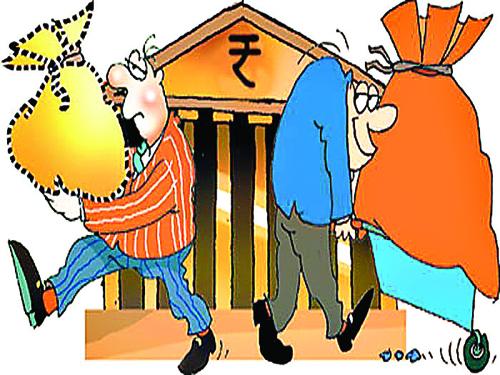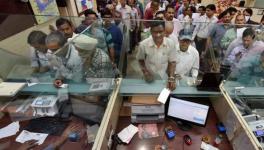Do Bank Bailouts Really Use Taxpayers’ Money?

India faces a massive NPA problem which not only continues to grow, but is even likely to worsen. The figures are alarming; NPAs grew by a whopping amount of Rs.3.13 lakh crores in the financial year 2018 to cross the Rs.10 lakh crores mark, amounting to some 11% of the total loans given by the commercial banking sector. The Reserve Bank of India (RBI) has further cautioned that Public Sector Banks (PSBs), which constitute about 70% of the banking system, are likely to see their NPAs worsen this year. India now faces one of the biggest NPA problems in the world— of crisis proportions, no doubt— with adverse implications for investment and inclusive growth.
Also Read: IDBI-LIC – Another Disaster In The Making
In situations when loans turn bad and must be written off, banks are compelled to do so against their capital, since adjustment against other creditors including depositors (bail-ins) is usually not permitted. When a bank’s capital is decimated by bad loans, bank lending suffers. Basel III norms, for instance, require capital adequacy of around 8% to 10.5% of the risk-weighted assets (bank loans) generated. Erosion of capital due to bad debt write-offs, therefore, constrains credit growth and consequently, investment and working capital finance across all sectors of the economy. With India’s PSBs accounting for a significant portion of NPAs, the immediate task on hand for the government is to infuse capital into these banks, meet adequacy norms, and restore their ability to lend.
THE POLITICAL FALLOUT OF BANK BAILOUTS
From privatisation of banks to the creation of a bad bank into which all NPAs can be hived off, from bank bail-ins to governance reforms, many solutions to the NPA crisis are being currently debated in India. However, the most pressing problem that cannot be circumvented is the recapitalization of banks. Raising money in the market would be one way to recapitalize a bank. However, a bank facing a severe NPA problem may not be able to do so in the markets without offering deep discounts on the price of its shares. Banks, especially PSBs, would therefore look to the government to infuse capital through a bailout package. A question that immediately follows is, “where does the government get the money to rescue the banks?” The most obvious answer is, “taxpayers’ money”. This leads us to rather hastily conclude that taxpayers bear the burden of rescuing a few crony capitalists, although in some instances the defaulters may well be over-indebted farmers. The political fallout of such a simplistic understanding of bailouts actually preempts recapitalisation plans and is instead making bank bail-ins the preferred option in many countries around the world.
TAXES DO NOT FUND GOVERNMENT SPENDING
At the core of this (mis)understanding lays the notion of money in neoliberal economics. It is taken for granted that taxes fund government spending. This is simply not true; state money comes into existence through government spending, by which the government effectively transfers real resources from the private sector to itself. The private sector accepts state money (an IOU or liability of the state) because it is mandatory that tax obligations be settled only in this money, issued by an economically sovereign government (rupees in India, dollars in the USA, pounds in Britain, and so on). State money consists of both, currency in circulation as well as reserve accounts held by commercial banks at the central bank. Governments, therefore, do not need taxes to spend. On the other hand, the private sector needs state money to settle its tax obligations to the state. Heterodox economics, Modern Money Theory (MMT) in particular, considers taxes as one way of draining the system of money in the hands of the private sector that if left in circulation, is likely to cause inflation. Fiscal deficits are nothing more than untaxed money spent into existence by the government. If governments were to run a fiscal surplus, then all that is spent by the government would have to be “returned” to it and some more too (from our savings). The obsession over fiscal deficits is therefore unfortunate and has been hyped in order to reduce the role of governments in the real economy to the minimum possible. This has been institutionalised through legislation like the Fiscal Responsibility and Budget Management (FRBM) Act of 2003, in India.
THE BANK RECAPITALISATION PROCESS
Consider a situation where the government decides to override some arbitrary fiscal deficit target (usually around 3%), and instead go ahead with writing-off all bad debts and recapitalise banks through simple and straightforward deficit financing, or what economists refer to as “printing money”. This process would begin by issuing bonds to the RBI against which its account at the RBI would be credited with reserve money. This reserve money would be transferred (credited) to the accounts of commercial banks by debiting the account of the government at the RBI. However, at the same time, the commercial banks would issue equity shares to the government against the reserve money credited into its accounts at the RBI. An additional problem could arise here; all else constant, the increase in reserve money with banks (or what is called liquidity) would cause a fall in interbank money market interest rates. To siphon off the entire excess liquidity infused by the government’s purchase of bank equity, and thereby maintain its target interest rate, the RBI would “sell” the government bonds it possesses to commercial banks in exchange for reserves. On careful scrutiny, it can be seen that the set of transactions between the government and commercial banks amounts to nothing more than a swap of government bonds for equity shares of banks. In all these transactions, the non-banking private sector’s balance sheet undergoes absolutely no change. Moreover, no additional tax burden is levied on it by the government to raise money for the recapitalisation of banks as is commonly touted. Once recapitalised, banks can meet their capital adequacy norms and restore the supply of credit in the economy.
Also Read: Is India’s Banking System Becoming like Humpty Dumpty?
What about the repayment of bonds in the longer term? Without discussing the MMT position on the myth that public debts impose a burden on future generations, it suffices to mention here that while the government has a long term liability (bond), it also acquires a long term asset (equity). In the short term, its interest payments on bonds could be offset by the dividend earned on equity.
BAILOUTS OR BAIL-INS?
The primary question about bailouts is not “where is the money for it”, but the moral hazard problem. If bad debt write offs were so easy— which is actually the case— then commercial banks can become complacent about taking risks in future. This is an issue the world continues to grapple, without any definite solution in sight. At the same time, a rejection of bank bailouts on the grounds that taxpayers are footing the bill of failed capitalists and distressed farmers, is leading governments to consider bank bail-ins as a more appropriate policy tool to deal with stressed banks. The Financial Resolution and Deposit Insurance (FRDI) Bill, 2017, has opened the doors to bank bail-ins in India, wherein bad debts of banks could be written off against the holdings of banks’ creditors including depositors and fixed deposit holders. While the FRDI has several safeguards to prevent abuse of bail-ins by banks, it could nonetheless lead to a breakdown in the public’s confidence in the banking system and a flight to cash just like it happened in Cyprus in 2013.
Also Watch: 4 Years of Modi Government and the Banking Sector
While this short analysis does not evaluate the options available to tackle the NPA crisis, it nonetheless makes possible, a fairer assessment of available policies by dispelling our naïve understanding of modern money and the myth that taxpayers actually fund government spending on bank recapitalisation.
Sashi Sivramkrishna’s book on India’s macroeconomy from a Modern Money Theory perspective will be published this year.
Get the latest reports & analysis with people's perspective on Protests, movements & deep analytical videos, discussions of the current affairs in your Telegram app. Subscribe to NewsClick's Telegram channel & get Real-Time updates on stories, as they get published on our website.
























